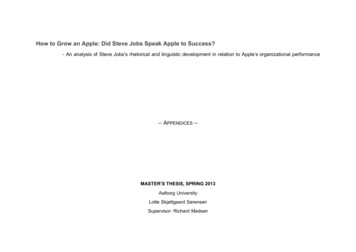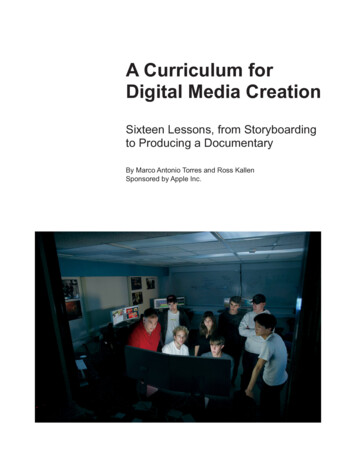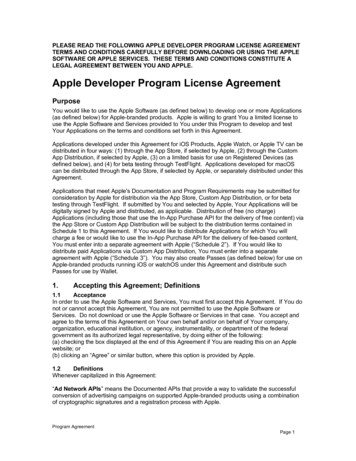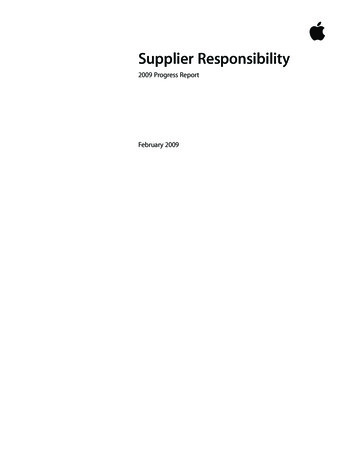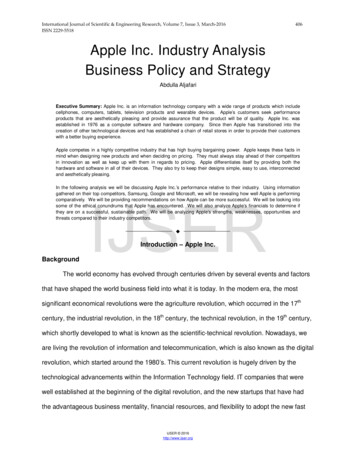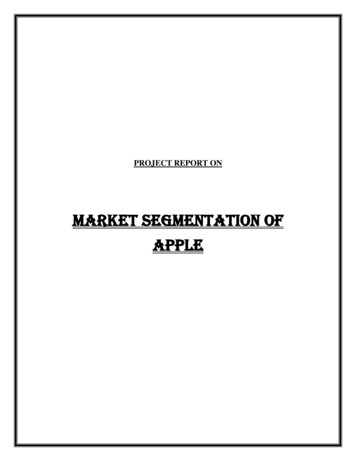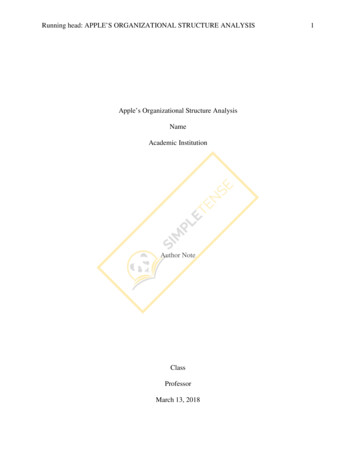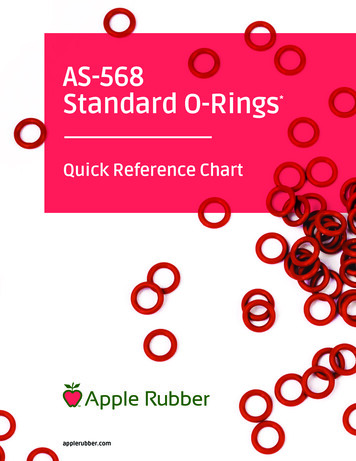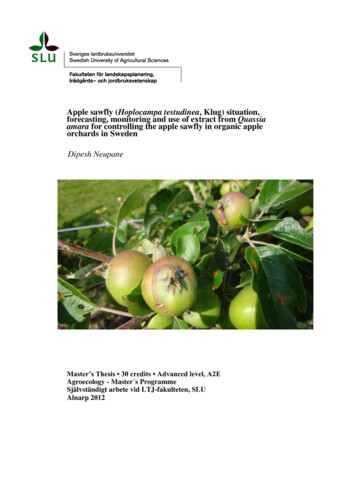
Transcription
Apple sawfly (Hoplocampa testudinea, Klug) situation,forecasting, monitoring and use of extract from Quassiaamara for controlling the apple sawfly in organic appleorchards in SwedenDipesh NeupaneMaster’s Thesis 30 credits Advanced level, A2EAgroecology - Master s ProgrammeSjälvständigt arbete vid LTJ-fakulteten, SLUAlnarp 2012
TitleÄpplestekeln (Hoplocampa testudinea, Klug): läget i Sverige,prognos, övervakning samt bekämpning med Quassia amaraextrakt mot äpplestekeln i svenska äppelodlingarDipesh NeupaneSupervisor:Weronika Swiergiel, PhD, Swedish University ofAgricultural Sciences, Department of PlantProtection BiologyCo-supervisor:Patrick Sjöberg, PhD, Swedish University ofAgricultural Sciences, Department of PlantProtection BiologyExaminer:Birgitta Rämert, Professor, Swedish University ofAgricultural Sciences, Department of PlantProtection BiologyType of student projects: Master s ThesisCredits: 30 creditsEducation cycle: Advanced cycle, A2ECourse title: Master’s Thesis in Agricultural ScienceCourse code: EX0486Programme: AgroecologyPlace of publication: AlnarpYear of publication: 2012Picture cover: Dipesh NeupaneTitle of series: Självständigt arbete vid LTJ-fakulteten, SLUOnline Publication: http://stud.epsilon.slu.seKeywords: Apple sawfly, Hoplocampa testudinea, Quassia extract,Quassia amara, forecasting, day degree model, semi structured interview.
ForewordThis is a degree to be submitted to the Faculty of Landscape Planning, Horticulture andAgricultural Science in partial fulfillment for the requirement of the degree of Agroecology –Master’s programme at the Swedish University of Agricultural Sciences, Alnarp.I visited an organic apple orchard for a group assignment during the course “AgroecologyBasics” on September 2010. That visit motivated me to acquire more knowledge aboutorganic production. Later on, I wrote a report about crop protection in organic apples for thecourse “Ecology of Production Systems” based on what I had gained through the farm visit. Imust say these two incidents arouse my interest to do this research project related to organicproduction. I got an opportunity to work for this research project with help of ProfessorBirgitta Rämert. Without her support, this thesis would not have been possible.This thesis has been a learning process. I have gained an immense knowledge about plantprotection in organic production and also different agroecological aspects. I have also beeneducated to work in a group and learnt about the importance of participation of differentstakeholders for success in any project. I believe it will be an important step in my personal aswell as professional development in future. I have tried to perform better under mysupervisors Weronika Swiergiel and Patrick Sjöberg. Both quantitative and qualitativemethods have been used to collect data, for instance, field trial as well as semi structured faceto face interviews were conducted for the project.i
AcknowledgementMy sincere gratitude goes to my great supervisors Weronika Swiergiel and Patrick Sjöberg forbeing so helpful and cooperative who always were ready to suggest and guide me throughoutthe entire period of the research. I would like to extend thanks to the Department of PlantProtection Biology for providing an opportunity to carry out this thesis and for cooperationduring the research period. A lot of thanks also go to organic apple growers Anders Månsson,Jörgen Nilsson, Per Christer Odén, Kalle Johansson, Marta Johansson and Göte Svenssonwithin the participatory research programme who were so much generous and provided plentyof information during the interviews. I would like to express my appreciation to an advisorfrom Äppelriket, Henrik Stridh for giving his time for the interview. I cannot forget tomention Jan Eric Englund for his guidance regarding the use of statistics. I am very grateful toour Master’s Thesis course coordinator Christina Kolstrup for her support during the courseand many thanks to her. Similarly, a lot of appreciation goes to Märit Jansson and JohanAscard for their valuable information.I would like to remember my family and friends for their moral support as well as inspirationduring the study period.ii
AbstractThe main objective of the thesis was to find out the growers’ perspective towards the problemof apple sawfly (Hoplocampa testudinea, Klug) as well as its solution, evaluate the suitabilityof Dutch and Swiss forecasting methods in Swedish environment, and evaluate the efficiencyand timing of Quassia extract application with varying concentration of rapeseed oil productZence 40 against the apple sawfly. The apple sawfly was monitored using white sticky trapsin two orchards located in Alnarp and Malmö. The forecasting models for emergence of firstsawfly (Dutch model) and egg hatch (Swiss model) were combined and used for determiningtiming of Quassia extract application. The model worked well for forecasting both the firstemergence and egg hatch of the apple sawfly. A field trial was conducted for sprayingQuassia extract as a control measure against the apple sawfly. The treatments were 1) Petalfall (PF), 2) Day degree low zence (DDL), 3), Day degree high zence (DDH) and 4) Control(C). The dose of Quassia was used at 12 kg per hectare in 400 liters of water. The percentageof the apple sawfly damage was significantly lower in all treatments compared to control with3.8%, 3.2%, 2.9% and 9.9 % damage in treatment 1, 2, 3 and 4. There was no difference insecondary damage between treatments. This could have been influenced by a large aphidinfestation at that time. Semi structured face to face interviews were carried out to get deeperunderstanding of the problem. Older orchards were found to have relatively more infestationcompared to new orchards. The growers were interested to continue the work with monitoringand trap catches in the coming season. They wished that the model should be proposed whichcan be used by the advisors from Äppelriket and the Board of Agriculture for forecasting theapple sawfly in Sweden.Key words: Apple sawfly, Hoplocampa testudinea, Quassia extract, Quassia amara,forecasting, day degree model, semi structured interview.iii
grated ProductionIntegrated Pest ManagementSveriges LantbruksuniversitetInternational Federation of Organic Agriculture MovementDay degreesParticipatory Rural AppraisalNon-Governmental OrganizationTreatmentPetal fallDay Degree Low ZenceDay Degree High Zence[Svenska] Jordbruksverketiv
Table of ContentsForeword Acknowledgement .Abstract .Abbreviations .1. Introduction1.1 Background 1.2 Aim .1.3 Literature review1.3.1 Apple cultivation in Sweden .1.3.2 Apple sawfly taxonomy and morphology .1.3.3 Apple sawfly description . .1.3.4 Forecasting of emergence and flight period of the apple sawfly .1.3.5 Apple sawfly damage .1.3.6 Natural enemies of the apple sawfly .1.3.7 Quassia amara .1.3.8 Participatory Rural Appraisal .2. Materials and Methods2.1 Phenology study2.1.1Calculation of day degrees .2.1.2 Installation of white sticky traps .2.1.3 Phenological stages .2.2 Field trial2.2.1 Experimental design .2.2.2 Quassia extract preparation and spraying .2.3 Participatory Rural Appraisal . 2.4 Damage calculation .2.5 Statistical analysis 3. Result3.1 Phenology study3.1.1Garden laboratory .3.1.2 Dammstorps Handelsträdgård 3.2 Field trial3.2.1 Primary damage 3.2.2 Secondary damage 3.3 Participatory Rural Appraisal .4. Discussion 5. Conclusion .6. References .7. Appendices .7.1 Appendix I 7.2 Appendix II 03538v
List of FiguresFigure 1Figure 2Figure 3Figure 4Figure 5Figure 6Figure 7Figure 8Figure 9Figure 10Figure 11Figure 12Figure 13Figure 14Apple sawfly adult and larva.Primary damage and Secondary damage from apple sawfly.Weather station in Dammstorp, Malmö.White sticky traps at the Garden laboratory and Dammstorp.Aerial photo of an experimental orchard in the Garden laboratory.Aerial photo of orchard in Dammstorps Handelsträdgård.Phenological stages of cultivar Discovery.Phenological stages of cultivar Rubinola.Graph showing day degrees, number of trap catches and phenologicalstages of cultivar Discovery.Graph showing day degrees, number of trap catches and phenologicalstages of cultivar Rubinola.Primary damage caused by the apple sawfly.Secondary damage caused by the apple sawfly.Interview sites.Aphids and infested leaves.List of TablesTable 1Table 2Table 3Table 4Different steps with recommended day degrees and minimum threshold.Application of Quassia extract against Hoplocampa testudinea in a fieldtrial (Alnarp, 2012).Participatory Rural Appraisal Tools.List of interviewees and interview sites.vi
1. Introduction1.1 BackgroundIn Sweden, conventional growing, integrated production (IP) and organic growing aregenerally practiced for apple cultivation. Many Swedish growers have changed their patternof growing from conventional to IP but only few steps are taken to start organic appleproduction (Jönsson, 2007). At the present situation, there is a burgeoning consumer interestin organic fruits (Zehnder et al., 2007). Jönsson (2007) also said that pests, diseases andweeds can cause severe problems in organic orchards. This limits the production of organicapples because of high degree of risks faced by the growers.This thesis is based on my interest on plant protection in organic production and also on theinterest shown by integrated and organic growers in a meeting with researchers from SwedishUniversity of Agricultural Sciences (SLU) discussing current and future research (pers.comm. Swiergiel, 2011). The growers wished to have a forecasting model for the applesawfly. The meeting was held on the 10th of February 2011. Organic growers in aparticipatory research group working on integrated pest management strategies in organicapple production also showed interest. They wished to know more about proper preparation,application and the efficacy of a botanical insecticide Quassia based on the bark of a shrubQuassia amara.1.2 AimThe aim of the research was to learn about the problem of the apple sawfly, Hoplocampatestudinea (Klug) in Swedish organic apple orchards and to evaluate the effectiveness andproper timing of Quassia extract application against the pest, Hoplocampa testudinea in anexperimental apple orchard based on the forecasting model developed by Zijp & Bloomers inNetherlands and Graf et al in Switzerland.1
1.3 Literature review1.3.1 Apple cultivation in SwedenApple is a fruit cultivated in temperate parts of the world. The apple Malus domestica belongsto the family Rosaceae and subfamily Maloideae (Currie, 2000). In the genus Malus, there areabout 25 to 30 species. In the middle of Sweden (Grönsöö), apple growing has beenauthenticated for around 400 years. During the 16th and 17th centuries, the Swedish kingsencouraged the growing of fruits in Sweden. The king’s deed was followed by the noblemenas they started planting fruits around their manor houses and castles. Later on the church andthe priests played a vital role for spreading the fruit growing knowledge to the society(Nilsson, 1986).The major apple growing is situated in the Southern Sweden especially around the villageKivik in 10-50 ha orchards (Jönsson, 2007) and Vånga in the north-east of Kristianstad (pers.comm., Swiergiel, 2011). Out of the total fruits produced in Sweden, apples constitute 85 %(Ascard et al., 2010). In 2005, the total apple yield was 17,683 tonnes from 1440 hectares ofland. In 2010, the total production (both conventional and organic) of apples was 23,500tonnes. The production has increased in a span of five years. It is also an increment of 12 % ascompared to 2009 (Jordbruksverket, 2010). The area of organic apple is increasing and thereis an approximately 130 hectares of organic apple production (pers. comm., Ascard, 2011).But the overall yield of organic apples is not satisfactory (pers. comm., Stridh, 2011).In Sweden, there is an organization accredited by International Federation for OrganicAgriculture Movement (IFOAM) that regulates organic production. This organization isknown as KRAV. It updates and follows the rules and regulations set up by IFOAM(Sandskär, 2003). It also adapts the rules since some rules are stricter than IFOAM. The goalof IFOAM is to adopt ecologic, social and economic systems worldwide based on theprinciples of organic agriculture (IFOAM, 2009). The Swedish Agricultural Policy considersorganic agriculture to be very potential for meeting its national environmental objectives andthe government is promoting it (Ascard et al., 2010).1.3.2 Apple sawfly taxonomy and morphologyApple sawfly (Hoplocampa testudinea) is an apple pest that belongs to the orderHymenoptera and family Tenthrinideae. Adults are 6 to 7 mm in length and the body is palefulvous brown or orange with black and shining thorax and abdomen (Miles, 1932). Wingsare generally more or less clear with dark brown veins (Fig. 1). The egg is oval, colorless,shiny and 0.8 mm in length (Alford, 1984). In about four to six weeks, the larvae becomemature. A mature larva measures about 9-11 mm long with yellowish brown head and whitecolored body (Fig.1). In early instars, the head is shining black at the vertex and pale on thefacial region (Miles, 1932).2
Fig.1 Apple sawfly adult (Photo: Weronika Swiergiel) and larva (Photo: Dipesh Neupane)1.3.3 Apple sawfly biologyThe apple sawfly Hoplocampa testudinea is a serious pest in commercial apple orchards(Alford, 1984) in Europe and North America (Graf et al., 1996a). Significant damages havebeen found in organic apple orchards in Europe as a result of apple sawfly (Zjip & Bloomers,2002a; Kienzle et al., 2006a). It has only one brood per annum (Miles, 1932). It remains as aprepupa within a cocoon in the soil. Diapause can sometimes last up to three years (Zjip &Bloomers, 1993). The sawfly pupa hatches and emerges around the blooming period of earlyand moderately early varieties (Zjip & Bloomers, 1993) such as Rubinola, Discovery, etc. Themale and female sawflies copulate within the first hours of emergence (Böhm, 1952; Graf etal., 2001). The apple sawflies need relatively warm and sunny weather with a lower thermalthreshold of about 11 C for reproduction (Graf et al., 2001). The female sawfly lays eggsingly on the receptacle of the flowers below the ring of sepals by a saw-like ovipositor(Alford, 1984). The female sawfly makes a small slit like cut on the receptacle with itsovipositor and egg is inserted inside. A sawfly female can lay an average 32 eggs rangingfrom 5-103 eggs in its life period (Dicker, 1953). The incubation period of eggs of applesawfly is 14-15 days at a temperature of 11-15 C.The larvae tunnel into the fruits and start to destroy developing fruitlets. The larva whichtunnels to the ovary usually reaches the third instar by that time. Full grown fifth instar larvaeabandon the fruit and start spinning the cocoon in which they hibernate inside the soil (Miles,1932). The larva begins its hibernation from June to the following spring (April or May). Thelarva can hibernate approximately at a depth of 8-23 centimeters (3-9 inches) under the soiland even below this depth.Graf et al (1996a) stated that the apple sawfly comes out of the soil at the same time when theearly apple varieties begin to flower which establishes a link between the reproductive periodof the apple sawfly and the phenological stages of the varieties. This coincidence is aprerequisite for infestation (Graf et al., 2001). Soil temperature determines the springemergence of the sawfly adults (Graf et al., 1996a). In the past, the biology of the apple3
sawfly has been studied and analyzed to find out effective control measures for the sawflyproblem (Miles, 1932., Dicker 1953). Field trials were conducted from 1949-1951 to find outthe effect of spraying on different timings such as 80% petal fall, 50% egg hatch and full egghatch (Dicker, 1953).1.3.4 Forecasting of emergence, flight period and egg hatching of the applesawflyGraf et al (1996a) developed a soil temperature driven phenology model to predict the flightperiod in a study carried out in Switzerland. The minimum threshold for post diapausedevelopment of the apple sawfly was found to be 4.5 C. The minimum threshold is theminimum temperature below which no growth occurs. The day degree (average temperaturesum) model has also been developed for forecasting emergence and egg hatching of the applesawfly. This model was developed by Zjip and Bloomers from Netherlands in 1997. A sum ofdegree days is the total amount of heat that is required for the development of an organismfrom one point to another point in the life cycle (University of California, 2003). Zjip andBloomers (1997) recommended that white sticky traps should be installed in the appleorchards at an accumulative value of 157 day degrees when calculated from 15th March withminimum threshold of 4 C. The day degree model uses the daily average air temperature andthe threshold temperature for the apple sawfly. The same author furthermore stated that thefirst emergence of the apple sawfly can be seen within a range of 177 10 day degrees (Table1). Zjip and Bloomers (1997) observed similar deviations between the mean air temperaturesum and the mean soil temperature sum. It implies that air temperature can also be used topredict the emergence of the first sawfly. Most private weather station measure only airtemperature.The apple sawfly adults are generally monitored using white sticky traps. White surfaces thatdo not reflect the ultraviolet light attract the apple sawfly as it considers those white surfacesto be blossoms (Owens & Prokopy, 1978; Andermatt Biocontrol, 2011). Monitoring methodfocusing on white sticky traps has been carried out in different countries in the past years(Owens & Prokopy, 1978; Wildbolz & Staub, 1986; Graf et al., 1996a). White stickyrectangular traps captured more sawfly adults compared to other surfaces such as blue, red,orange, green, yellow, and black enamels (Owens & Prokopy, 1978). Traps installed in theupper portion of the trees captured more sawflies than lower part (Wildbolz & Staub, 1986).Graf et al (2002) developed a forecasting model which predicts when the eggs of the applesawfly hatch into first instar larvae. The model explained that egg hatching of the applesawfly is generally observed at a thermal constant of 85 day degrees with a thresholdtemperature of 6.9 C from the period when the eggs are laid. The thermal thresholdtemperature for egg development is greater than the post diapause development of the applesawfly. It is based on the fact that temperature requirement for post diapause developmentalstage is lower as compared to stages during the egg development (Zjip & Bloomers, 1997).4
The forecasting of either pests or even diseases can be very important from bothenvironmental as well as economic point of view. It reduces the amount of syntheticchemicals such as pesticides, fungicides, etc. going into the environment. This will eventuallylead to a lower cost of application for the growers (Zehnder et al., 2007). The forecastingsystem can reduce the damag
Figure 9 Graph showing day degrees, number of trap catches and phenological stages of cultivar Discovery. Figure 10 Graph showing day degrees, number of trap catches and phenological stages of cultivar Rubinola. Figure 11 Primary damage caused by the apple sawfly. Figure 12 Secondary dama
